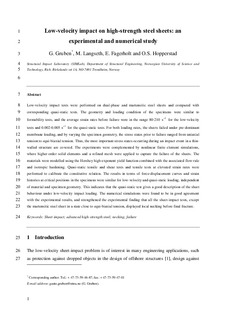| dc.contributor.author | Gruben, Gaute | |
| dc.contributor.author | Langseth, Magnus | |
| dc.contributor.author | Fagerholt, Egil | |
| dc.contributor.author | Hopperstad, Odd Sture | |
| dc.date.accessioned | 2017-12-21T08:54:57Z | |
| dc.date.available | 2017-12-21T08:54:57Z | |
| dc.date.created | 2016-01-13T08:21:14Z | |
| dc.date.issued | 2016 | |
| dc.identifier.citation | International Journal of Impact Engineering. 2016, 88 153-171. | nb_NO |
| dc.identifier.issn | 0734-743X | |
| dc.identifier.uri | http://hdl.handle.net/11250/2473399 | |
| dc.description.abstract | Low-velocity impact tests were performed on dual-phase and martensitic steel sheets and compared with corresponding quasi-static tests. The geometry and loading condition of the specimens were similar to formability tests, and the average strain rates before failure were in the range 80–210 s−1 for the low-velocity tests and 0.002-0.005 s−1 for the quasi-static tests. For both loading rates, the sheets failed under pre-dominant membrane loading, and by varying the specimen geometry, the stress states prior to failure ranged from uniaxial tension to equi-biaxial tension. Thus, the most important stress states occurring during an impact event in a thin-walled structure are covered. The experiments were complemented by nonlinear finite element simulations, where higher-order solid elements and a refined mesh were applied to capture the failure of the sheets. The materials were modelled using the Hershey high-exponent yield function combined with the associated flow rule and isotropic hardening. Quasi-static tensile and shear tests and tensile tests at elevated strain rates were performed to calibrate the constitutive relation. The results in terms of force-displacement curves and strain histories at critical positions in the specimens were similar for low-velocity and quasi-static loading, independent of material and specimen geometry. This indicates that the quasi-static test gives a good description of the sheet behaviour under low-velocity impact loading. The numerical simulations were found to be in good agreement with the experimental results, and strengthened the experimental finding that all the sheet-impact tests, except the martensitic steel sheet in a state close to equi-biaxial tension, displayed local necking before final fracture. | nb_NO |
| dc.language.iso | eng | nb_NO |
| dc.publisher | Elsevier | nb_NO |
| dc.rights | Attribution-NonCommercial-NoDerivatives 4.0 Internasjonal | * |
| dc.rights.uri | http://creativecommons.org/licenses/by-nc-nd/4.0/deed.no | * |
| dc.title | Low-velocity impact on high-strength steel sheets: An experimental and numerical study | nb_NO |
| dc.type | Journal article | nb_NO |
| dc.type | Peer reviewed | nb_NO |
| dc.description.version | acceptedVersion | nb_NO |
| dc.source.pagenumber | 153-171 | nb_NO |
| dc.source.volume | 88 | nb_NO |
| dc.source.journal | International Journal of Impact Engineering | nb_NO |
| dc.identifier.doi | 10.1016/j.ijimpeng.2015.10.001 | |
| dc.identifier.cristin | 1311548 | |
| dc.relation.project | Norges forskningsråd: 237885 | nb_NO |
| dc.description.localcode | © 2015. This is the authors’ accepted and refereed manuscript to the article. This manuscript version is made available under the CC-BY-NC-ND 4.0 license http://creativecommons.org/licenses/by-nc-nd/4.0/ | nb_NO |
| cristin.unitcode | 194,64,45,0 | |
| cristin.unitname | Institutt for konstruksjonsteknikk | |
| cristin.ispublished | true | |
| cristin.fulltext | postprint | |
| cristin.qualitycode | 2 | |

